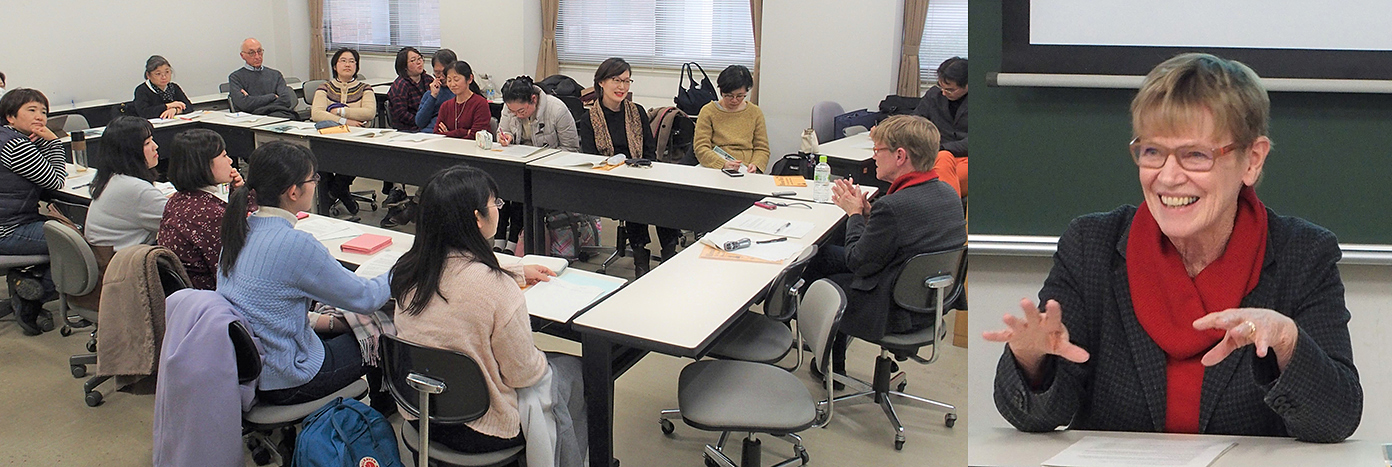IGS Seminar: “Millennial Maiko: The Geisha Apprentice in Japanese Popular Culture”
An IGS Seminar titled “Millennial Maiko: The Geisha Apprentice in Japanese Popular Culture,” featuring a lecture by Dr. Jan Bardsley (Specially Appointed Professor, IGS; Professor, North Carolina University Chapel Hill) was held on February 8, 2019. Bardsley researches the representation of women in modern Japan. In this seminar, Bardsley examined representations of maiko (geisha apprentices) in Japanese films in the 1950s and 2000s, analyzing how the status of maiko in Japanese society has changed. At this seminar, Bardsley screened the Japanese films A Geisha (1953), So Young, So Bright (1955), and the NHK-TV morning drama Dandan (2008).

In the 21st century, maiko are popularly depicted as cute mascot characters of Kyoto. Although only 75 people actually work in Kyoto as maikos, the cultural and commercial presence of the maiko image is far greater. Depictions of maiko dressed in beautiful kimono and donning traditional hairstyles appear everywhere in Kyoto, such as on posters that are meant to attract tourists and as Hello Kitty dolls. Most strikingly, contemporary maiko images lack any reference to the dark underworld of human trafficking and prostitution.
In the storylines of the 1950s films, girls become maiko to escape financial difficulties. For these girls, it is a survival strategy. Entertaining rich men, depending on sponsors, and eventually “being bought” as a wife or mistress were all socially recognized methods for geisha and maiko to make a living. Therefore, mastering dance, tea ceremony etiquette, and flower arranging was a strategy for improving their value as merchandize.
In A Geisha, the teacher of a flower arranging class encourages a group of maiko to train hard, saying: “Have self-respect and take pride in being the symbol of … Japanese beauty while you study every day.” In So Young, So Bright, a mother who was once a geisha sarcastically responds to criticism expressed by her daughter’s female teacher that “the geisha world is filthy,” saying, “They all think that the geisha is the enemy of the housewife, but the geisha does have her charming aspects. That is why the husband goes to see her. I think it is fine for a woman to imitate what other women do well.” In this statement, she acknowledges the sexual subjectivity of the geisha and expresses pride in being more attractive and feminine than housewives and having confidence in holding a status higher than that of prostitutes.
On the other hand, in the 2008 TV drama Dandan, becoming a maiko is presented as a career choice along the road of self-discovery. Moreover, the professionalism of the job is justified as a noble endeavor to master traditional arts such as dance. Customers who seek out geisha are depicted as intellectuals who appreciate the quality of their traditional performing arts. In these representations, sexual aspects of the maiko are erased. One of the main characters in the drama is the grandmother of a maiko. Her knowledge of the geisha world is identical to depictions from the 1950s films. For her, geisha agencies and parlors are filthy places. However, she changes her opinion after watching a serious and elegant traditional dance performed in a parlor. This scene represents the de-sexualization of the geisha world, and is exactly what current Gion society (the Kyoto geisha world) seeks to promote. Such millennial maiko images scrubbed of sexual imagery have been combined with the Japanese adjective “kawaii,” meaning cute, and is one of the driving forces of contemporary Japanese popular culture. Therefore, the maiko image displaced the famous beauty of the geisha and became the mascot of the ancient Japanese city of Kyoto.
After the presentation, many questions were asked and several comments were made, and an enthusiastic discussion took place. Bardsley is writing a book on maiko and the content of this seminar will appear as a chapter in the book. She said that the discussion after the seminar has helped her enhance the content of the book. We are very much looking forward to its publication.
Kumi Yoshihara (Project Research Fellow, IGS)
【Event Information】http://www2.igs.ocha.ac.jp/en/events/2019/01/0208/

